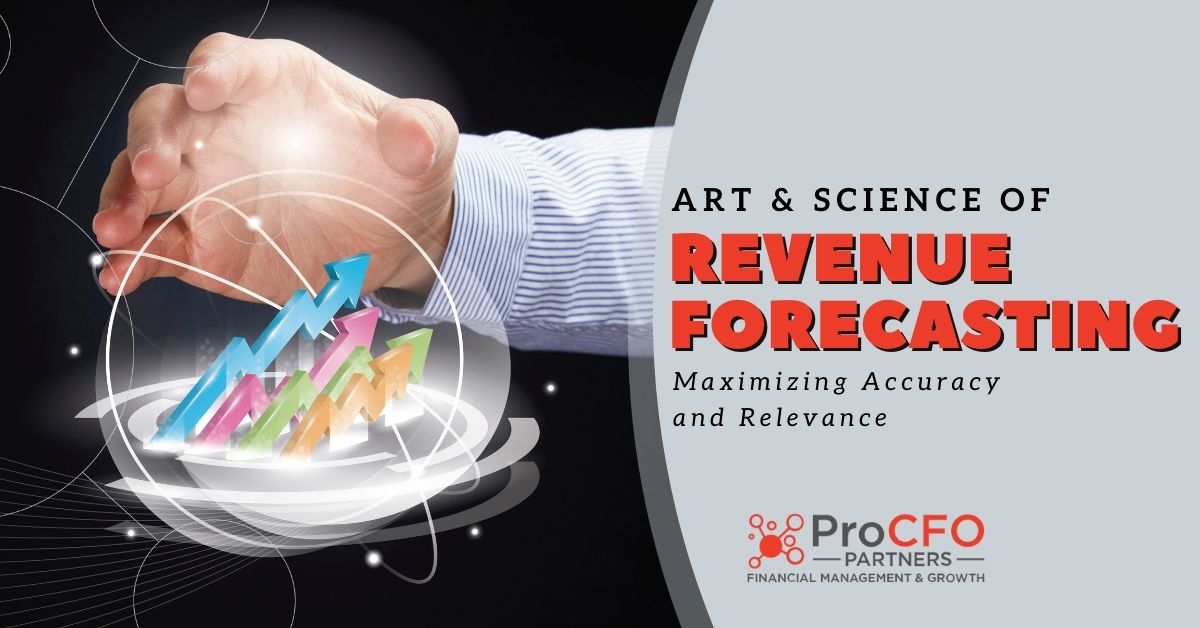The Art & Science of Revenue Forecasting
Dec 26, 2023
Revenue forecasting is an important aspect of business planning and financial management. Accurate and relevant revenue forecasts help you make informed decisions, allocate resources effectively, and set realistic financial goals. However, revenue forecasting is not without its challenges. The complex and dynamic nature of markets, changing consumer behaviors, and unforeseen external factors can make revenue forecasting daunting.
Let’s discuss the art and science of revenue forecasting, focusing on maximizing accuracy and relevance. We will explore the nuances of revenue forecasting, discuss strategies for improvement, and highlight the role of the CFO in the process.
The Nuances of Revenue Forecasting
Regular revisiting and updating of revenue forecasts
A key aspect of revenue forecasting is the need for regular, predictable revisiting and updating. Revenue forecasts should not be treated as static numbers but as living documents requiring constant evaluation and refinement. Monthly or quarterly reviews are vital to ensure accuracy and relevance.
Businesses must stay ahead of the curve by closely monitoring market trends, consumer behavior, and any external factors that may impact revenue. You can adjust your strategies by continuously updating revenue forecasts and making timely decisions based on the most up-to-date information. Collecting and aggregating that information requires input from your entire team.
Refining forecasts for improved accuracy
Revenue forecasts should be based on a thorough analysis of historical data and trends to maximize accuracy. By studying past performance, you can identify patterns and make informed projections for the future. Be sure to include factors such as seasonality, sales cycles, and any specific trends relevant to your industry.
However, it is equally important to incorporate external factors and market conditions into revenue forecasting. Changes in the economy, industry regulations, or competitive landscape can significantly impact revenue. By combining these external factors into forecasts, you can better anticipate potential challenges and adjust their strategies accordingly.
Finally, your forecast can only be as strong as the data that informs it. Teams, departments, products, regions and whatever else drives or influences revenue in your business should be part of the forecasting conversation. Getting accurate numbers is essential – and sometimes harder than it needs to be. This is where company culture plays a perhaps unexpected role.
The role of culture in revenue forecasting
Creating a culture of data-driven decision-making is crucial for accurate and relevant revenue forecasting. This involves fostering an environment where decisions are based on insights derived from data and analytics rather than gut feelings or assumptions. Frankly, when departments are strictly motivated by numbers output (or fear of not making quotas), you might see numbers that are more optimistic than actual, of numbers that move around the calendar to look better than maybe they are. Accuracy is essential, so setting up a culture of candor – where people aren’t afraid to share less-than-great news, is important.
Encouraging cross-functional collaboration is another essential aspect of building a data-driven culture. Revenue forecasting requires input from various departments, such as sales, marketing, finance, and operations. You can gather valuable insights and perspectives to inform their revenue forecasts by building collaboration and open communication into your organization’s culture.
Improving Revenue Forecasting
Identifying areas of improvement
To maximize the accuracy and relevance of revenue forecasts, we have to assess current forecasting processes and identify any gaps or pain points.
Evaluate the tools, systems, and methodologies used for revenue forecasting. Are they outdated or inefficient? Are there any bottlenecks in the process that hinder accuracy and relevance? By pinpointing these areas of improvement, you can take targeted actions to enhance your revenue forecasting capabilities.
Implementing best practices
Leveraging advanced analytics and forecasting tools can significantly improve the accuracy of revenue forecasts. These tools can analyze vast amounts of data, identify patterns, and generate more accurate predictions. By embracing technology and incorporating these tools into the forecasting process, you can make more informed decisions.
Scenario planning and sensitivity analysis are also valuable techniques for improving revenue forecasting. These methods allow you to simulate various scenarios and assess the impact on revenue. You can develop more robust and flexible forecasts by considering different possibilities and their potential outcomes.
Incorporating feedback and continuous improvement
As mentioned, gathering feedback from the sales, marketing, and finance teams is essential for improving revenue forecasting. These teams have valuable insights and perspectives that can help identify blind spots and areas for improvement. By involving them in the forecasting process and regularly seeking their feedback, you can enhance the accuracy and relevance of forecasts.
Moreover, revenue forecasting should be an iterative and adaptive process. You should continuously refine your forecasting processes as you gather more data and insights. This continuous improvement mindset ensures that revenue forecasts evolve with the changing dynamics of the market and the business itself.
The CFO’s Role in Revenue Forecasting
Leadership and guidance from the CFO
The CFO sets the vision and strategy for revenue forecasting within the organization. They are responsible for ensuring that revenue forecasts align with the overall financial goals of the business. They provide leadership and guidance to the finance team, ensuring they have the necessary resources and tools to forecast revenue accurately. By setting clear expectations and establishing a culture of accuracy and relevance, the CFO can drive the effectiveness of revenue forecasting within the organization.
Collaboration with other departments
Back to that culture of candor – your CFO should work closely with the sales and marketing teams to align their efforts with revenue forecasts. The CFO can make more informed revenue projections by understanding the sales pipeline, marketing strategies, and customer behaviors. The right financial leader will help these teams understand the importance of accuracy and encourage its regular reporting.
Collaboration with operations and supply chain teams is also critical. These teams have insights into production capacity, inventory levels, and potential bottlenecks affecting revenue. With this involvement, your CFO can ensure that revenue forecasts consider operational realities and constraints.
If you don’t have a CFO or are concerned about taking a CFO on, consider the benefits of a fractional or part-time CFO. At ProCFO Partners, our expert CFOs can help with revenue forecasting and other strategic imperatives while insulating you from full-time-employee overhead or commitment.
Conclusion
Revenue forecasting is a vital aspect of business planning and financial management. Accurate and relevant revenue forecasts help businesses make informed decisions, allocate resources effectively, and set realistic financial goals. Maximizing the accuracy and relevance of revenue forecasts requires a combination of data-driven decision-making, cross-functional collaboration, and continuous improvement. Implementing best practices, leveraging advanced analytics, and gathering feedback from various departments is essential, and the CFO plays an important role in providing leadership, guidance, and collaboration to ensure accurate and actionable revenue forecasting within the organization.


